Milky Way
July~August is the season when the Milky Way looks exceptionally bright and beautiful.
Nowadays, it is difficult to see because the lights of the Milky Way are drowned out by too many people’s lights, but if you go to a high altitude away from the city, you may be able to see it.
The author and others only see the videos and photos introduced on TV.
They say that even moonlight can be disturbing, so the light of the Milky Way is really pale and secret.
The Milky Way is called so because the center of the Milky Way, a large cluster of disk-shaped stars, looks like a river flowing north-south in the sky when viewed from the Earth, which is located near the end of the Milky Way.
Basically, you should be able to see something throughout the year, but in Japan, at this time of summer, the Milky Way looks darker because it faces the center of the galaxy, which is the densest concentration of nebulae.
The Milky Way has been visible since ancient times BC.
Naturally, however, it was difficult to accurately recognize its identity.
Aristotle seems to have thought that the Milky Way was not a star, but a meteorological phenomenon in the upper atmosphere, and Philoponus, who studied and commented on Aristotle’s scholarship in the 6th century, felt uncomfortable that there was too little parallax for a meteorological phenomenon, but did not go so far as to refute it, and the 11th century Islamic scholar Haitham also observed the Milky Way and said that it was “a phenomenon occurring farther away than the moon.” He said.
The first person to confirm that the Milky Way is an aggregate of countless stars was Galileo Galilei in the 17th century.
Galilei was a famous scholar who strongly advocated the heliocentric theory, which had been ignored until then, and he showed us the methods of scientific research that lead to the present day, that no matter how authoritative the theory of a scholar, whether it is Aristotle or anyone, we should not take it for granted, but verify it with our own experiments and investigations.
By the way, the episode in which he succumbed to the pressure of the church, which was the authoritative force at the time, and muttered, “The earth still rotates,” may have been added later by the disciples (laughs).
Now, during this season, when the Milky Way brightly colors the sky, Tanabata festivals are held all over the country.
The Tanabata Festival was originally a Chinese imperial event. It seems that it was a wish for improvement in needlework, etc., and this was transmitted to Japan during the Heian period and spread among the aristocracy.
In the Edo period, it seems that it was a festival associated with Shinto rituals as a precursor to the Obon festival, but in modern times, it is an annual event for children, leaving only the shape and generally just displaying strips of paper with wishes written on the bamboo.
Speaking of which, the “Neputa Festival” in Aomori and the “Kanto Festival” in Akita are also events that originated in Tanabata and there seems to be a theory that they were sacred rituals of “sleep flow” to exorcise and wash away sleep demons = dirt that attack during agricultural work (this theory was first proposed by folklorist Kunio Yanagida, but it seems that there was a difference in interpretation among the locals about the origin of “Neputa”).
The Tanabata Festival is held on July 7 according to the old custom, but according to the current new calendar, it will be a long time ago, for example, August 22 in 2023.
I see, I thought that the Milky Way would look like Matomo at the height of the rainy season, but it was originally an event in the latter half of August.
Even in the haiku world, “Tanabata” has become a seasonal word for autumn.
By the way, when I was reading the materials about Tanabata, there was an interesting description. In relation to the fact that Tanabata is originally a Shinto ritual, “most Shinto rituals are performed at 1 a.m.,” and the time is called “the night of dawn.”
Since “sacred rituals” are essentially “arcane rituals”, we know that they are performed at midnight, but what is “night of dawn”?
It is a passage that appears in the children’s song “Kagome Kagome”, but it is meaningless when you think about it ~.
“Dawn” refers to before and after the sun rises, and “night” refers to night.
Contradictory, isn’t it?
I will stop pursuing this because it is almost useless, but I decided to enjoy thinking that by using such a contradiction, I am creating a mysterious and fantastic worldview that transcends human knowledge.

By Admin|2023-06-30|2023,News Release|
